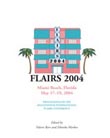Published:
May 2004
Proceedings:
Proceedings of the Seventeenth International Florida Artificial Intelligence Research Society Conference (FLAIRS 2004)
Volume
Issue:
Proceedings of the Seventeenth International Florida Artificial Intelligence Research Society Conference (FLAIRS 2004)
Track:
All Papers
Downloads:
Abstract:
Traditional approaches to semantics give a logical, settheoretic account of category conjunction, where an item is a member of a conjunction A&B only if it is a member of both single categories A and B. However, people do not always follow this logical approach when classifying items in conjunctions. For example, Hampton (1988) found that people typically classify blackboards as non-members of the single category “furniture”, but as members of the conjunction “school furniture”. This paper describes a computational model intended to explain this “overextension” of conjunctive categories, and an experiment testing this model using conjunctions of controlled, laboratory-learned categories.

FLAIRS
Proceedings of the Seventeenth International Florida Artificial Intelligence Research Society Conference (FLAIRS 2004)
ISBN 978-1-57735-201-3
Published by The AAAI Press, Menlo Park, California.
